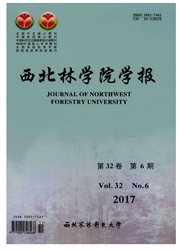

 中文摘要:
中文摘要:
以长势一致的1年生国槐和侧柏幼苗为供试材料,采用盆栽控水试验,测定不同水分条件下(土壤相对含水量分别为田间持水量的100%、80%、60%、40%)和铅胁迫下(土壤铅含量为0、300、500、1000、2000、4000、6000、8000、10000、12000mg·kg^-1)国槐和侧柏叶绿素含量和叶绿素a/b的变化。结果表明:在生长初期铅胁迫下的国槐和侧柏的叶绿素含量总体呈下降趋势,中间有一个波峰,分别出现在4000和1000mg·kg^-1,国槐叶绿素含量下降的幅度大于侧柏的;水分胁迫下国槐叶绿素含量成下降趋势,侧柏略有上升;干旱和铅双重胁迫下土壤相对含水量为40%土壤铅含量为500mg·kg叫的国槐全部死亡,叶绿素a/b呈下降趋势且波动较大,而侧柏无一死亡,波动幅度较小;土壤相对含水量为100%,60%和40%时侧柏叶绿素a/b的值随铅含量变化不大且一直高于国槐。国槐和侧柏叶绿素含量对干旱和铅胁迫有一个适应和自我补偿机制,表现为低浓度的促进和高浓度的抑制;在生长初期国槐较之侧柏对铅更敏感,水分比铅对两种植物的影响更大,侧柏比国槐的耐旱性和抗铅性更强。
 英文摘要:
英文摘要:
Dynamic changes of the contents of chlorophyll a/b occurring in the 1-year-old seedlings of Platycladus orientalis and Sophora japonica that were under drought (with soil relative water contents of 100%, 80%, 60%, and 40%, respectively) and lead stress (with the soil lead contents of 0, 300, 500, 1 000, 2 000, 4 000, 6 000, 8 000, 10 000, and 12 000 mg· kg-1, respectively) were examined. The re- sults demonstrated that in their initial growth stages, the contents of chlorophylls decreased generally in two tree species under lead stress, however, intermediate maximum peaks appeared in the plants that were cultivated in the soils with the lead contents of 4 000 and 1 000 mg · kg-1. Moreover, the decrease ampli- tude of chlorophylls in S. japonica was greater than P. orientalis. Under water stress, the chlorophyll contents of S. japonica deceased, and slightly increased in P. orientalis. Under double stresses, seedlings of S. japonica died in the soils with the water content of 40% and lead content of 500 mg · kg-1 , while the contents of chlorophyll a/b decreased. On the contrary, none of P. orientalis seedlings died, and the contents of chlorophyll a/b were relatively stable. The chlorophyll a/b contents of P. orientalis changed a little with the increase tent of 100%, 60%, a of Pb content, and larger than S. japonica in the soils with the relative water connd 40%. It was concluded that a self-compensation mechanism existed in two tree species under drought and lead stresses, manifested as promotion at low levels of stress and inhibition at high levels of stress. In the initial growth stages, S. japonica was more sensitive to lead than P. orientalis. Draught stress had stronger influence than And P. orientalis had a stronger drought tolerance and lead resistance than S. japonica.
 同期刊论文项目
同期刊论文项目
 同项目期刊论文
同项目期刊论文
 期刊信息
期刊信息
